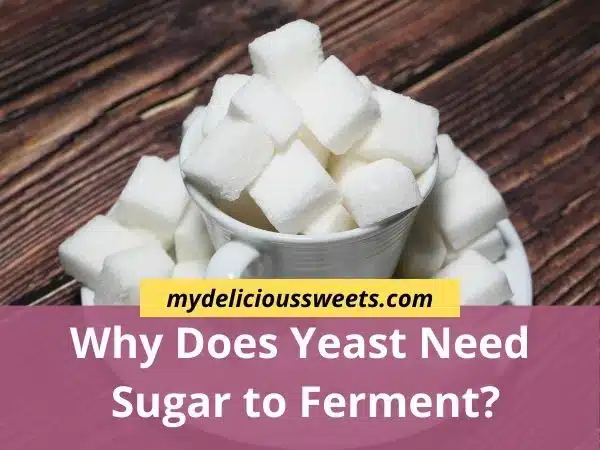Yeast, a single-celled organism and type of fungus, plays a crucial role in producing soft and tasty baked goods, as well as beer and wine, through its fermentation activity. During fermentation, yeast generates alcohol and carbon dioxide. However, have you ever wondered why yeast requires sugar to work?
Yeast relies on sugar for fermentation because sugar serves as a vital food source that yeast cells metabolize to produce energy, alcohol, carbon dioxide, and flavor compounds. Without sugar, yeast lacks the necessary fuel to carry out fermentation effectively.
Although sugar is commonly used in baked goods, it’s important to note that not all recipes require added sugar. Certain bread types, such as sourdough bread, depend solely on the natural sugars present in the flour and the fermentation process itself for flavor and texture development.
When no added sugar is present, the yeast’s activity slows down, consequently reducing the rate of fermentation. This slower process, however, promotes the development of rich flavors.

The Role of Sugar in Yeast Fermentation
Sugar plays a vital role in yeast fermentation by serving as an energy source for yeast metabolism.
Various sugar molecules, including sucrose, glucose, and fructose, provide the necessary energy for yeast cells. During the process of glycolysis, yeast breaks down sugar into simpler compounds, generating adenosine triphosphate (ATP), which serves as a source of cellular energy.
Byproducts of Yeast Fermentation
Carbon dioxide: One of the significant byproducts of yeast fermentation is carbon dioxide (CO2). As the yeast consumes sugar, it undergoes anaerobic respiration, resulting in the production of CO2 gas. The released CO2 becomes trapped within the dough, creating air pockets that cause the dough to rise during baking.
Alcohol: Apart from carbon dioxide, yeast also produces ethanol, a type of alcohol, during fermentation. While most of the ethanol evaporates during baking and aids in dough rising, a small amount may contribute to the flavor profile of specific bread varieties.
Flavor compounds: As the yeast consumes sugar and produces CO2 and ethanol, it also generates various flavor compounds and volatile organic compounds that contribute to the unique taste and aroma of bakery products. These compounds are often responsible for bread’s “yeasty” or “fermented” aroma.
Sugar Sources for Yeast
1. Enzymatic Breakdown of Starches
In the bread-making process, water is added to bread flour to create dough. Within the dough, there are enzymes present, both naturally occurring in the flour and those produced by the yeast. These enzymes, known as amylases, act on the starch present in the flour, breaking it down into smaller sugar molecules, primarily maltose.
The flour itself contains trace amounts of naturally occurring sugars, such as sucrose and fructose. Rye flour typically contains higher levels of amylase enzymes compared to wheat flour.
2. Added Sugar
Bakers often incorporate granulated or powdered sugar directly into the yeasted dough to enhance flavor and provide sweetness. Sugar is a dough conditioner that contributes to a soft crumb and crust, as well as extends the shelf life of bakery products.
Additionally, certain recipes may include natural sweeteners like honey or molasses. These sugars dissolve within the dough, contributing to the overall taste and consistency of the final product.
The Impact of High Sugar Content on Yeasted Dough
While a small amount of added sugar stimulates yeast activity, high sugar levels can have negative effects on fermentation and ultimately impact the quality of bakery products.
Inhibited yeast activity: High concentrations of sugar can hinder yeast activity and slow down fermentation. This occurs because sugar is hygroscopic, meaning it absorbs and retains the water that yeast requires for fermentation. Insufficient moisture availability can lead to reduced carbon dioxide production, poor dough rising, and a denser crumb.
Weakened gluten structure: Excessive sugar softens the gluten structure, affecting the dough’s elasticity and strength. This can result in a dense, collapsed, or crumbly texture in bread. Furthermore, increasing the sugar content in the dough prolongs the mixing time as it takes longer for the gluten structure to develop.
Extensive Crust Browning: high sugar content can cause excessive browning and crust caramelization, resulting in an overly dark or burnt appearance of the crust. Baked goods with a high sugar content may also have a rubbery crust rather than a crispy one.
For bakery products with high sugar content, using a lower baking temperature can prevent excessive and overly rapid browning of the crust.
Final Thoughts
In summary, sugar serves as the fuel that powers yeast metabolism, facilitating the production of carbon dioxide, ethanol, and flavor compounds during fermentation. Without sugar, yeast would be unable to carry out these processes, resulting in flat, dense, and flavorless baked products.
Understanding the crucial relationship between yeast and sugar helps bakers achieve optimal results and consistently produce delicious, fluffy bread. While on the subject of sugar and yeast, you may be interested in my article on what happens if you don’t add sugar to the yeasted dough.

